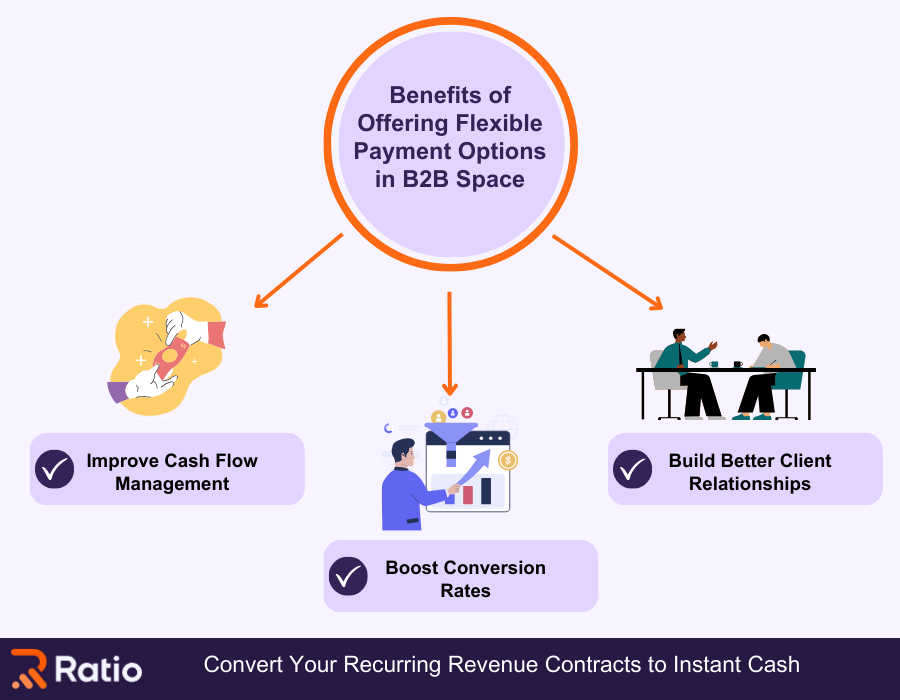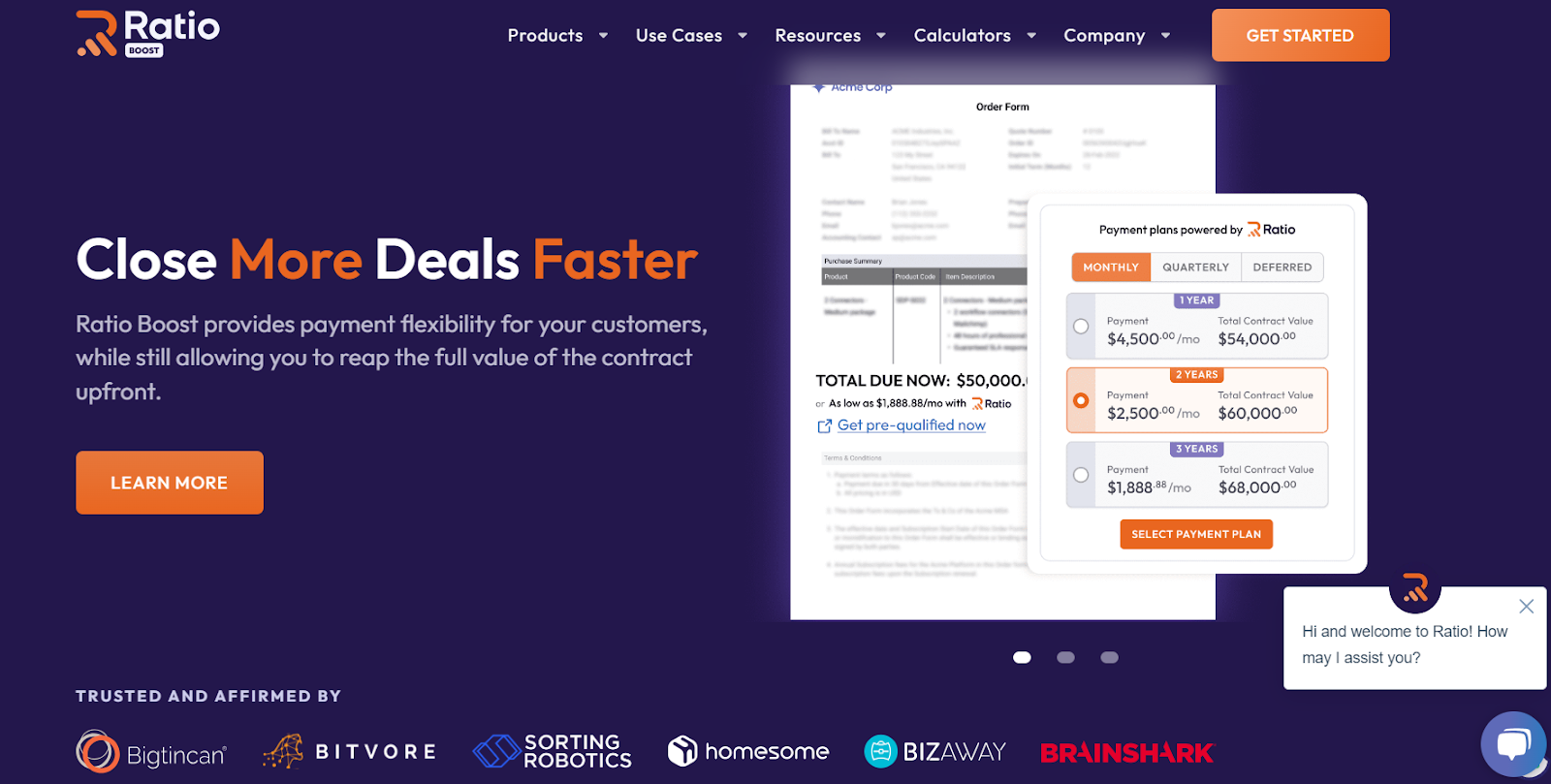Are you tired of chasing delayed payments and worrying about your company's cash flow? If so, you're not alone.
55% of all B2B invoiced sales are overdue in the United States at the moment, while an average 9% of all credit-based B2B sales are affected by bad debts.
These figures highlight the urgent need for businesses to reconsider their approach to payments. Late B2B payments and increasing debt severely impact a company's financial health, jeopardizing its existence.
Fortunately, there is a solution: flexible payment terms.
By adopting flexible payment terms, you can cater to your customers' needs, improve their financial management, and make it possible for them to afford bigger purchases.
Moreover, a flexible payment system makes your company look more customer-centric and helps you stand out.
Now, while you offer this payment flexibility, you can access almost the whole contract value upfront, with revenue-based financing partners like Ratio by your side.
This guide offers tailored insights for B2B entrepreneurs ready to upgrade payment practices and unlock the benefits of offering flexible payment terms.
Understanding B2B Payment Flexibility
Buying a product or service with payment flexibility allows buyers to defer full payment until later or opt for tailored payment terms.
This flexibility is crucial for several reasons:
- The current economic conditions have made businesses vigilant about their expenditure. The ability to spread out B2B payments allows businesses to maintain liquidity and invest in growth without being affected by cash flow constraints. This approach reduces financial burdens, helping with strategic budgeting and financial planning.
- Many B2B customers have diverse financial structures, budgeting cycles, and credit lines, rendering rigid payment structures ineffective. Sellers are willing to adapt to these differences by offering flexible payment terms. This customer-centricity fosters long-lasting business relationships.
From extended payment terms to customizable installment plans, B2B payments have evolved to suit modern commerce.
Today's payment solutions are not just transactional tools but integral components of a business's financial strategy. Gartner's 2020 report predicts that by 2025, 80% of buyer-seller interactions in the B2B space will be digital, a significant transformation from traditional payment methods.
Problems with Traditional Payment Methods
Businesses have long relied on B2B payments such as paper checks, ACH transfers, wire transfers, credit card payments, and cash for their wide accessibility, dependability, simplicity, and personal connection.
Like a double-edged sword, these methods have downsides that can impact business operations and customer relationships.

🔸Inefficiencies in Older Systems
For instance, paper checks must be physically handled, mailed, and manually recorded, which can cause delays and errors. On the other hand, wire transfer might involve several intermediaries, prolonging the process.
Such inefficiencies can lead to late payments, affecting a business's capital.
🔸Issues with Security and Fraud Prevention
Traditional payment options are prone to fraud and security breaches. A notable example was in July 2021, when a ransomware attack impacted up to 1,500 small and medium-sized businesses, as The New York Times reported.
In addition, 56% of U.S. companies faced fraud attempts in 2022, with paper check fraud topping the list.
These security lapses lead to financial losses and harm customer trust. Customers often look for safer and more efficient payment alternatives.
🔸Lack of Flexibility and Scalability
Conventional B2B payments limit visibility and scalability. They hinder adaptation to new payment conditions, currencies, or structures.
Physical checks are slow, and bank account transfers need scheduling or invoice-matching features. These methods become cumbersome, leading to missed growth opportunities.
🔸Longer Time Spent on Approval
Conventional methods slow down payment cycles in terms of processing, tying up both capital and valuable time. It's common for businesses to sink 6-10 hours a month into managing these payments, a significant chunk of time that could otherwise fuel strategic growth.
This inefficiency hampers more than just cash flow; it chips away the time that could be invested in driving the business forward.
Benefits of Offering Flexible Payment Options in B2B Space
The B2B payment market is set to boom, targeting a 10.1% CAGR by 2030. Yet, 67% of buyers might bail if they can't pay their way, highlighting the need to offer flexible payment terms.
Case in point: Apple's 2021 shift to 60-day supplier terms. It’s a clear signal stiff payment practices are out; flexibility is in, or you risk choking on your capital and piling up inventory.
Businesses syncing with buyer payment preferences aren’t just playing it smart; they're banking on the B2B market's explosive growth. Let's break down the key benefits of flexible payment terms.

✅Improve Cash Flow Management
Cash is king, and running dry is a business killer, hitting 82% of failed ventures. However, flexible payment options offer a clear advantage by empowering buyers to manage cash flow effectively.
Buyers can pay in manageable installments instead of a heavy upfront payment, keeping their working capital healthy and avoiding budget squeezes. It’s a game-changer, especially for businesses riding the ups and downs of seasonal sales or tight budgets.
For example, consider Ratio's partnership with a MarTech SaaS vendor. Offering net 30, 60, and 90-day terms, Ratio alleviated cash flow challenges for Creative C. The flexibility allowed Creative C to defer payments as needed, ensuring financial stability and an 81% reduction in DSO.
✅Boost Conversion Rates
Tight budgets make it hard for businesses to pay for services simultaneously. Offering flexible payment terms eases this burden, letting customers pay over time and stay within budget.
Take The Elephant Pants: CFO James Brooks saw sales double in two months by customizing wholesale payment terms.
Adding flexible online payment options, like installment plans and Buy Now, Pay Later, smooths the purchase process. It can increase your average order size, improve conversions, reduce abandoned carts, and raise your bottom line.
✅Build Better Client Relationships
Research shows that 84% of B2B buyers lean towards vendors they trust. Tailored payment plans that fit customers' financial constraints are pivotal in fostering loyalty and having a competitive advantage.
Offering flexible payment terms attracts new customers and ensures existing ones remain. Prioritizing customer loyalty through flexible payment methods is a wise strategy for steady revenue enhancement.
Challenges and Solutions in Implementing Payment Flexibility in B2B Space
While flexible payment terms can enhance client relationships and cash flow management, it can be challenging.
Vague payment terms like "payment upon receipt" or "payment due within 30 days" will confuse clients, burdening both parties. Such a lack of visibility can disrupt capital and trust.
As a result, it is important to understand the pitfalls of flexible payment terms. Listed below are some of the common problems, along with solutions.
1. Transparency Issues in Payment Terms
Unclear payment terms can be a real headache for businesses and their customers. 78% of B2B buyers consider brand transparency one of their top three factors when making purchasing decisions.
Lack of transparency in B2B payment terms can spell trouble, resulting in disputes, delays, and strained customer relationships.
Businesses should communicate payment terms using clear and straightforward language and collaborate with trustworthy B2B payment service providers.
2. Managing Credit Risk
Extending flexible payment terms can raise the risk of delayed payments, harming cash flow and financial stability. Poor handling of flexible payments can result in cash flow problems that affect operational capabilities.
Regularly evaluating the creditworthiness of clients and adapting terms is necessary to mitigate these risks. Utilize predictive analytics to identify potential defaults in advance.
To further enhance risk management, collaborate with B2B payment providers that handle underwriting risks through reference checks, credit limit establishment, credit report reviews, and a true sale structure.
3. Insufficient Monitoring
Inadequate monitoring tools for payment tracking and credit limits can hinder businesses significantly. Without proper oversight, managing accounts receivable becomes complex, increasing credit risk and potential revenue losses.
It's not uncommon for businesses to see up to 10% of their monthly revenue eaten away by mishandling flexible payment solutions.
To address these issues, businesses should employ advanced real-time payment and credit limit monitoring tools. Automating reminders for overdue payments helps minimize financial losses and improve buyer experience.
4. Inadequate Payment System Integrations
A poorly integrated payment system can disrupt operations, affecting both customer experience and internal processes.
Integrating flexible payment plans at the point of sale within the sales workflow using ready-made payment system integrations goes a long way in minimizing friction as well as reducing admin hassles associated with the payment process.
Future Trends in B2B Payment Flexibility
For companies to excel in the global market, advancing B2B payment methods is essential. Blockchain and cross-border improvements are reshaping financial transactions. As automation gains popularity, the demand for new payment technologies increases.
Here are the key B2B payment trends to watch.
🔸Increased Adoption of Digital and Contactless Payments
The digital B2B payment market is on a strong growth path, expected to hit $8.2 billion by 2028, with a solid annual growth rate of 14.3%. The push for speed and convenience in transactions is driving this growth, leading to a boom in contactless payment methods.
Digital wallets and payment apps are riding this wave, becoming the go-to for seamless, instant transactions for consumers and businesses alike.
🔸Rise of Blockchain Transactions
Blockchain is revolutionizing B2B international payments, predicted to exceed $4.4 trillion by 2024. This leap from $171 billion in 2019 is driven by blockchain's speedy, secure, and cost-effective solutions, cutting out banks as intermediaries.
Real-time validation through blockchain protocols accelerates transactions, enhances transparency, and reduces fraud. Companies like IBM are at the forefront, innovating in the blockchain payment space, reducing transaction fees, and enhancing financial security.
🔸Integration of AI and Machine Learning
A Microsoft survey found that 79% of small business owners plan to adopt AI to transform businesses with enhanced fraud detection, optimized payments, and predictive analytics.
B2B payments are accelerating, going digital, streamlining, and businesses staying ahead will lead globally. Knowing the ropes and staying adaptable is crucial for making the most of these trends.
Introducing Ratio Boost: A Modern Solution for B2B Payment Flexibility
The B2B payments market is booming and is set to surpass $111 trillion by 2027. However, small businesses need more support due to outdated traditional payment systems, leading to serious cash-flow issues.
Amid this growth, the digital commerce landscape is evolving rapidly, with Buy Now, Pay Later (BNPL) options becoming essential. They offer convenience for buyers and security for sellers, and this is where Ratio's Boost comes into play.
Boost reimagines the BNPL service, allowing sellers to provide flexible payment plans to the buyers, with Ratio providing them almost full contract value upfront. Say goodbye to cash-flow worries.
Whether buying, selling, or doing both, Boost tailors financing to your exact needs, with Ratio handling the underwriting risk.

Here are the standout features that make Boost your ideal flexible payments enabler:
- Low customer acquisition costs, simplifying base growth.
- Increased deal closures without resorting to discounts.
- Instant capital for sellers and flexible payment terms for buyers.
- Ratio has over $400 million in capital ready to support financing businesses like yours.
- Backed by a team of experienced SaaS entrepreneurs and finance experts.
Curious to experience the difference? Dive into the Ratio app and see for yourself.
Let Ratio manage your financials; it could give your business the edge it needs in the dynamic B2B payment market.







.png)


